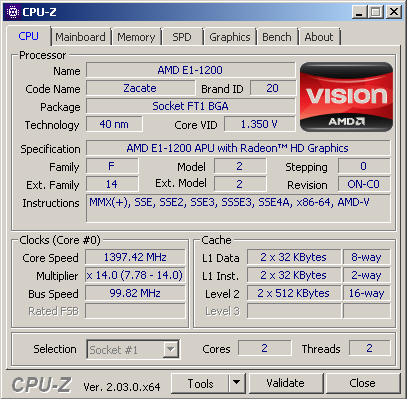SuperPi - 1M score 55sec 754ms with a E1-1200
Thursday, 01 January 1970 07:00 | Update at null
Media Gallery
Screenshot

Device, Setup, etc



URL
https://hwbot.org/submission/4955478https://www.facebook.com/hakimnu.id/posts/3250622965170344
Information Detail
Hardware: AMD E1-1200
Specs:CPUID : AMD E1-1200 APU with Radeon(TM) HD Graphics
Architecture : x86
Codename : Zacate
L3 Cache : -
Clock : 1.4GHz
Core/Thread : 2/2
TDP : 18W
Technology : 40nm
Socket : FT1 BGA 413-Ball
IGPU : AMD Radeon HD 7310
See more specification...
Software: SuperPi - 1M
Score: 55sec 754ms
About: SuperPi - 1MSuperPi - 1M is one of the classic and popular benchmarks used to measure single-thread CPU performance by calculating the number π (pi) to 1 million decimal places. This benchmark has long been a favorite benchmark among tech enthusiasts, overclockers, and hardware testers due to its simplicity, speed, and accuracy in directly assessing processor performance.
In SuperPi 1M testing, only one CPU core is used to complete the calculation as quickly as possible. This makes it ideal for assessing the single-core capability of a CPU, especially in scenarios where single-core performance remains highly relevant, such as in lightweight applications, gaming, or everyday use.
Despite its simplicity, SuperPi 1M is highly sensitive to clock speed, memory latency, and processor architecture efficiency. As a result, this benchmark is often used as a standard in overclocking competitions, as even small differences in system configuration can lead to significantly different execution times.
Features and Advantages:
- Calculates 1 million digits of the number π (pi) with precision.
- Emphasizes the single-thread performance of the processor.
- Runs quickly, ideal for repeated testing.
- Suitable for comparing CPU architecture efficiency.
- Still widely used in the global overclocking community.
Despite the availability of many modern benchmarks, SuperPi 1M remains a significant tool in CPU testing due to its direct representation of basic computational performance. This benchmark is also lightweight and compatible with nearly all Windows versions, making it a practical tool for quick system evaluation.
Released in 2012 as part of the Brazos 2.0 family, the AMD E1-1200 is a power-efficient processor aimed at entry-level laptops. It has a 2 core and 2 thread configuration with a fixed clock speed of 1.4 GHz, with no support for Turbo Core technology. Built with a 40nm fabrication process, the E1-1200 has a TDP value of 18 watts-efficient enough for portable devices that emphasize low power consumption and longer battery life. Despite its limited performance, the E1-1200 was a popular choice in its day thanks to its affordable price and ability to handle light computing needs.
One of the main advantages of the AMD E1-1200 is the integrated Radeon HD 7310 GPU, which offers better graphics performance than Intel's entry-level graphics solutions at the time. This GPU has the ability to play HD resolution videos smoothly, as well as run light games such as Counter Strike 1.6, Plants vs Zombies, or other casual games with minimum graphics settings. That said, this combination of CPU and GPU is not intended for heavy-duty work such as video editing, 3D rendering, or modern gaming. Overall performance is more optimal when used for tasks such as browsing, streaming videos, accessing social media, typing documents, as well as basic office applications.
However, it should be noted that the AMD E1-1200 is less suitable for heavy multitasking, especially in modern operating systems like Windows 10. With a low clock speed and no Boost feature, users may experience lag or limitations when opening multiple applications at once. In tests using the HP 1000 1b05au laptop, this processor was paired with 4GB DDR3 single channel RAM (2 DIMM slots) and tested on Windows 7, Windows 8, and Windows 10 operating systems. The results show that the most optimal performance is achieved on Windows 7 or Windows 8, while in Windows 10 the system tends to be slow although it can still be used for basic needs. As such, the AMD E1-1200 can still be relied upon as a power-efficient and inexpensive solution for users with very light computing needs.
Hardware Detail:
Device: HP 1000 1b05au
RAM: 4GB DDR3 Single Channel 2 DIMM
OS: Windows 7, Windows 8, Windows 10
* Not Avaiable
